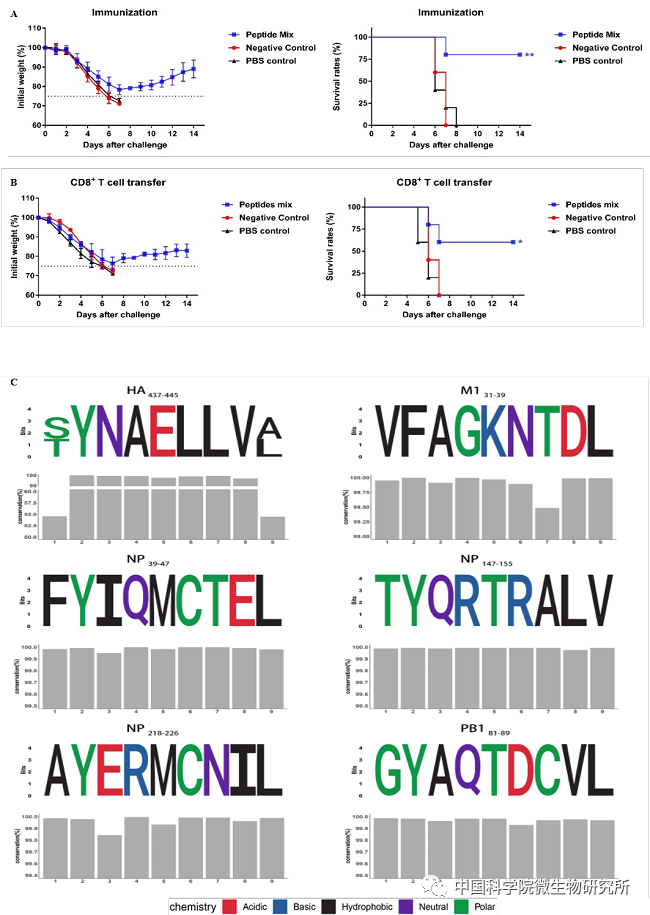博文
[转载]中国科学家设计出新型佐剂流感疫苗
|||
中国科学家设计出新型佐剂流感疫苗

目前,流感病毒仍然是威胁人类公共卫生健康领域的重要呼吸道病原之一,季节性流感爆发或偶发的流感病毒跨种传播和大流行给人类健康和社会经济带来重大影响。
疫苗免疫是预防流感病毒感染最有效的方法,当前疫苗免疫策略主要通过诱导识别流感病毒血凝素蛋白HA的特异性中和抗体抵御病毒感染。
然而,流感病毒作为RNA病毒,基因组突变频率较高,产生抗原漂移,或发生基因重排导致抗原转换,针对上述流感病毒的潜在威胁,迫切需要研究新型、广谱性的通用流感疫苗,以期实现对不同流感毒株的有效保护。
面对变化多端的流感病毒,有效激活针对病毒保守结构区域的免疫应答是实现广谱性流感疫苗的有效方法,一系列研究在小鼠、雪貂等模型中证明靶向病毒保守结构区域,如基质蛋白M2或HA茎部区域的特异性抗体能够有效治疗或预防不同流感毒株的感染。
然而,相对繁琐的免疫方式以及抗体引发的一些副作用等问题仍有待进一步解决优化。研究证实,在缺乏中和抗体的条件下,针对病毒保守结构域的特异性T细胞应答能够有效介导针对不同毒株的交叉保护性反应,提示特异性T细胞应答反应在新型广谱性流感疫苗设计中的潜在价值。
中科院微生物所孟颂东团队十多年来长期从事热休克蛋白gp96免疫学功能研究,该团队近期研究发现,以热休克蛋白gp96为佐剂联合商业性单价灭活H1N1流感疫苗免疫小鼠,能够有效诱导小鼠产生针对H1N1、H3N2、H7N9等不同亚型流感病毒毒株的保护性免疫应答。
进一步免疫学机制研究表明,以gp96蛋白为佐剂联合单价灭活流感疫苗免疫小鼠,能够显著增强疫苗特异性T细胞应答反应,有效诱导小鼠产生针对不同毒株的交叉反应性CD8+ T细胞应答,活化多个针对病毒结构蛋白NP、HA、M1、PB1保守结构区域的CD8+ T细胞应答反应。
免疫保护实验证明,这6个针对病毒保守结构域的特异性T细胞表位可以发挥协同作用,共同介导gp96佐剂诱导的交叉保护。利用生物信息学方法比对3万余株流感病毒序列,结果表明上述6种保护性T细胞表位能引发交叉保护应答并在所有比对序列中高度保守(下图),提示以gp96为佐剂的新型流感疫苗具有广谱性应用潜力。
图例: 6个流感病毒保护性保守T细胞表位可引发对不同毒株的交叉免疫保护(A和B),以及在不同毒株中的序列比对结果(C)。
孟颂东团队利用汉逊酵母、昆虫杆状病毒等蛋白表达系统实现了临床级别重组gp96蛋白的快速大量制备(J Biotechnol, 2011, 151(4): 343-349)。下一步将在灵长类动物模型中验证该疫苗的交叉保护潜力。鉴于T细胞应答在清除病毒感染、介导交叉保护中的核心作用,以gp96为佐剂的新型广谱性流感疫苗设计,也为其它重要传染性疾病病原的新型佐剂疫苗研发提供了新的思路。
上述研究已经在线发表在Journal of Virology杂志网站——Han Zhang, Huaguo Zheng, Peng Guo, Liuyi Hu, Zihao Wang, Jiuru Wang, Ying Ju, Songdong Meng. Broadly protective CD8+ T cell immunity to highly conserved epitopes elicited by heat shock protein gp96-adjuvanted influenza monovalent split vaccine. Journal of Virology, 2021, DOI: 10.1128/JVI.00507-21. https://jvi.asm.org/content/early/2021/04/02/JVI.00507-21
本文转载自“中国科学院微生物研究所”微信公众号。
Currently, immunization with inactivated influenza virus vaccines is the most prevalent method to prevent infections. However, licensed influenza vaccines provide only strain-specific protection and need to be updated and administered yearly; thus, new vaccines that provide broad protection against multiple influenza subtypes are required. In this study, we demonstrated that intradermal immunization with gp96-adjuvanted seasonal influenza monovalent H1N1 split vaccine could induce cross-protection against both group 1 and group 2 influenza A viruses in BALB/c mice models. Vaccination in the presence of gp96 induced an apparently stronger antigen-specific T cell response than split vaccine alone. Immunization with the gp96-adjuvanted vaccine also elicited apparent cross-reactive CD8+ T cell response that targeted the conserved epitopes across different influenza virus strains. These cross-reactive CD8+ T cells might be recalled from a pool of memory cells established after vaccination and recruited from extra-pulmonary sites to facilitate viral clearance. Of note, six highly conserved CD8+ T epitopes from the viral structural proteins HA, M1, NP and PB1 were identified to play a synergistic role in gp96-mediated cross-protection. Comparative analysis showed that most of conservative epitope-specific CTLs apparently induced by heterologous virus infection were also activated by gp96-adjuvanted vaccine, thus resulting in broader protective CD8+ T cell responses. Our results demonstrated the advantage of adding gp96 to an existing seasonal influenza vaccine to improve its ability to provide better cross-protection.
Owing to continuous mutations in hemagglutinin (HA) or neuraminidase (NA) or recombination of the gene segments between different strains, influenza viruses can escape the immune responses developed by vaccination. Thus, new strategies aimed to efficiently activate immune response that targets to conserved regions among different influenza viruses are urgently needed in designing broad-spectrum influenza vaccine. Heat shock protein gp96 is currently the only natural T cell adjuvant with special ability to cross-present coupled antigen to MHC I molecule and activate downstream antigen-specific CTLs response. In this study we demonstrated the advantages of adding gp96 to monovalent split influenza virus vaccine to improve its ability to provide cross-protection in BALB/c mice model and proved that gp96 activated cross-reactive CTL response is indispensable in our vaccine strategy. Due to its unique adjuvant properties, gp96 might be a promising adjuvant for designing new broad-spectrum influenza vaccines.
https://blog.sciencenet.cn/blog-212210-1286246.html
上一篇:基因技术的十大惊人用途
下一篇:21世纪医学十大重大进步
